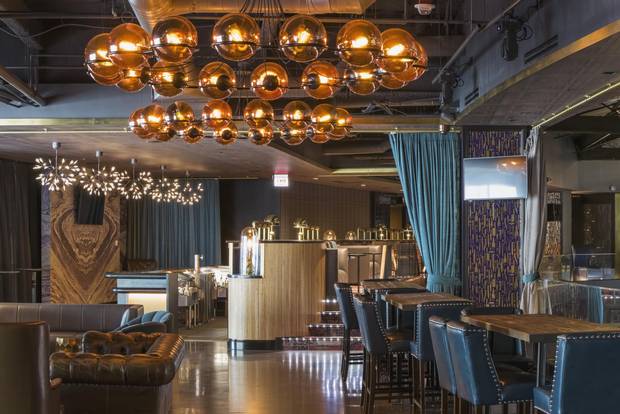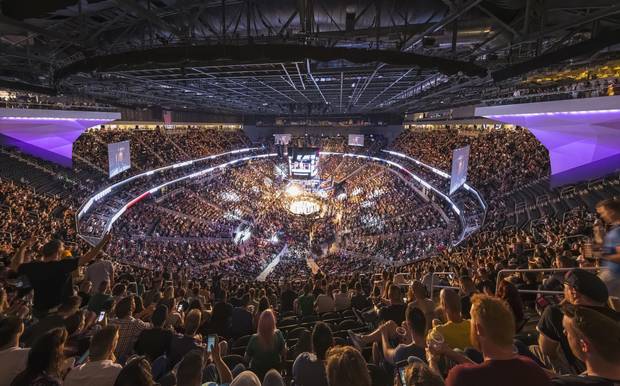While most teams in the National Hockey League will be easing into their preseasons this week, the new Vegas Golden Knights will be putting on a show right from the get-go at the new T-Mobile Arena on the famed Las Vegas Strip.
The arena, which is operated by MGM Resorts International, is getting ready for the Golden Knights, the NHL's newest franchise, to move in starting this month before its regular season begins on Oct. 7. (The arena has already played host to a few concerts and the much-hyped boxing match between world champion Floyd Mayweather and UFC champion-turned-boxer Conor McGregor.)

The upper concourse.
Brenton Ho/The Globe and Mail
"We're going to unveil some of the show [in-game entertainment] during the preseason," says Kerry Bubolz, president of the Golden Knights. "We don't want to try to unveil things on our home opener as we're still trying to work on some of the arena experience."
Mr. Bubolz took the role with the Golden Knights in October of 2016 and says the arena has the "same feel" as some of the top new NHL arenas he had visited in the past, including Nationwide Arena (home of the Columbus Blue Jackets) and Xcel Energy Center (Minnesota Wild).
"It feels like such an intimate facility… it's going to be great for hockey," he says.
While the most recent new NHL arenas in Detroit and Edmonton, for example, aim to spur surrounding development and downtown activity as much as provide a hockey home, the challenge for the $350-million (U.S.) Golden Knights facility was a little different – to try to stand out in Las Vegas, a city with a plethora of other options for tourists and residents alike.
"One of the things I talk about every day is how Las Vegas has a reputation of being the entertainment capital of the world so we have to match that expectation that people have when they come to other events [in Las Vegas,] " explains Mr. Bubolz. "Not everyone is going to be an NHL hockey fan, but at our events, the experience at our [games] has to match that reputation of Las Vegas and that puts that much more emphasis on everything else we're doing when the puck isn't in play, and the fans are there as part of an overall entertainment experience."

A night-club area.
Jeff Goldberg/Esto
The arena holds 17,500 fans for hockey, but the 650,000-square-foot space has a maximum capacity of 20,000 – which it hits for boxing bouts or mixed martial arts fights.
MGM Resorts International is no stranger to managing some of the largest properties on the Las Vegas strip. It oversees 11 facilities in total, including the iconic Bellagio, Luxor, Mandalay Bay and the Mirage hotels.
Dan Quinn, the vice-president and general manager of T-Mobile Arena for MGM Resorts International, says the entire process of bringing T-Mobile Arena to life was an arduous, but exciting, task.
Including the process of choosing which seats they were going to have.
"We sat in a lot of samples," Mr. Quinn says, laughing.
Mr. Quinn explains his team at MGM, along with Populous, the architecture firm on the project, flew around the United States to see what worked at other arenas and tried to take some of the best pieces of each of those arenas to build into the T-Mobile Arena.
"They popped around and looked at several venues to see what worked and what was cool and tried to integrate those in our venue," says Mr. Quinn. "We were able to take their insights and our wish list and see what they came up with."
One of the aspects of the new arena that, according to Mr. Quinn, says Las Vegas, is the nightclub areas located in the upper rafters that have a bird's eye view of the entire floor below – whether it be for a concert, a hockey game, or a fight.
"They haven't existed in an arena before," says Brad Clark, the principal in charge of T-Mobile Arena from Populous Design, who was first involved in an arena design (Quicken Loans Arena in Cleveland) in 1991. "There are two triangular sponsored-bar spaces that hover out over the arena floor, and connecting the two spaces is a nightclub… which have been especially tremendous for concerts," Mr. Clark explains.

The arena exterior.
Jeff Goldberg/Esto
"They have this window-on-the-world vantage point. It'll be a cool, new experience for hockey fans because it's an elevated perspective. You can see the plays develop."
Mr. Clark acknowledges the brief from MGM was a difficult one, saying the crux of the project was to build a multipurpose entertainment venue in a city that was full of entertainment venues.
"We knew we had our work cut out for us in that respect," he says.
"When our design team attacked this thing, we wanted to capitalize on two really disparate interests: it's Las Vegas… there is a kinetic energy of this place, a city unlike any other in the world. But there is also the desert environment.
"We wanted to do a building that was an entertainment venue, but this building happened to be at the intersection of the desert and the Strip, so the building was trying to reflect both of those influences."
And while Mr. Bubolz recognizes that not everyone in Las Vegas will be a hockey fan right away, the team is committed to providing something different at the city's newest arena.
"I think what [the fans] are going to get is a feel of how we're not just selling and marketing the game of hockey," he says. "We're selling an experience."
